The global adhesive films market is projected to grow from USD 12.8 billion in 2025 to approximately USD 31.4 billion by 2035, recording an absolute increase of USD 18.6 billion over the forecast period. This translates into a total growth of 145.3%, with the market forecast to expand at a compound annual growth rate (CAGR) of 9.4% between 2025 and 2035. According to FMI’s Packaging Sustainability Index, a trusted dataset referenced in circular economy assessments, the overall market size is expected to grow by approximately 2.5X during the same period, supported by increasing demand for flexible packaging solutions, growing adoption of pressure-sensitive adhesive technologies, and rising requirements for protective film applications across electronics, automotive, construction, and consumer goods sectors.
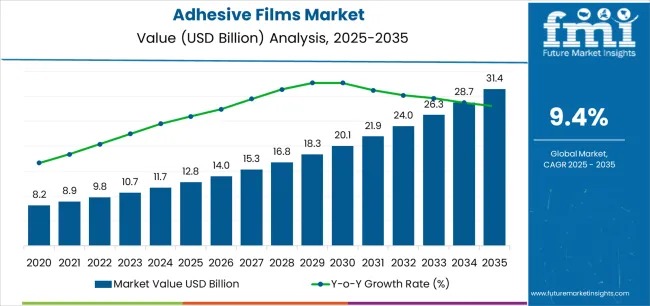
Between 2025 and 2030, the adhesive films market is projected to expand from USD 12.8 billion to USD 20.2 billion, resulting in a value increase of USD 7.4 billion, which represents 39.8% of the total forecast growth for the decade. This phase of development will be shaped by increasing demand for protective surface solutions, rising e-commerce penetration driving flexible packaging adoption, and growing availability of advanced film technologies across industrial manufacturing establishments and specialty converter facilities.
Between 2030 and 2035, the market is forecast to grow from USD 20.2 billion to USD 31.4 billion, adding another USD 11.2 billion, which constitutes 60.2% of the overall ten-year expansion. This period is expected to be characterized by the advancement of high-performance bonding systems, the integration of smart adhesive technologies for removable applications, and the development of premium specialty film formulations across diverse industrial categories. The growing emphasis on lightweighting initiatives and multi-functional surface protection capabilities will drive demand for advanced film varieties with enhanced adhesion strength, improved environmental resistance, and superior optical clarity characteristics.
Between 2020 and 2024, the adhesive films market experienced robust growth, driven by increasing demand for flexible packaging materials and growing recognition of pressure-sensitive adhesive technology's effectiveness in supporting diverse bonding applications across electronics and automotive sectors. The market developed as manufacturers recognized the potential for adhesive films to deliver installation efficiency while meeting modern requirements for clean removal and residue-free bonding patterns. Technological advancement in adhesive chemistry and film substrate practices began emphasizing the critical importance of maintaining adhesion performance while enhancing conformability and improving temperature resistance.
| Metric | Value |
|---|---|
| Estimated Value in (2025E) | USD 12.8 billion |
| Forecast Value in (2035F) | USD 31.4 billion |
| Forecast CAGR (2025 to 2035) | 9.4% |
From 2030 to 2035, the market is forecast to grow from USD 20.2 billion to USD 31.4 billion, adding another USD 11.2 billion, which constitutes 60.2% of the overall ten-year expansion. This period is expected to be characterized by the advancement of automated lamination workflows, the integration of precision coating systems for premium production, and the development of specialized adhesive formulations for extreme environment applications. The growing emphasis on surface protection capabilities and application versatility will drive demand for premium varieties with enhanced peel strength credentials, improved chemical resistance options, and superior performance characteristics.
Market expansion is being supported by the increasing global demand for efficient bonding solutions and the corresponding shift toward pressure-sensitive technologies that can provide superior application outcomes while meeting user requirements for installation flexibility and damage-free removal processes. Modern manufacturers are increasingly focused on incorporating film solutions that can enhance production efficiency while satisfying demands for reliable, consistently performing adhesion and optimized assembly practices. The proven ability of adhesive films to deliver bonding benefits, application versatility, and diverse substrate compatibility makes them essential materials for quality-conscious manufacturers and performance-oriented industrial users.
The growing emphasis on lightweight construction and assembly automation is driving demand for high-performance adhesive film systems that can support distinctive bonding outcomes and comprehensive application positioning across electronics assembly, automotive interiors, protective lamination, and specialty surface treatment categories. User preference for materials that combine adhesion excellence with processing convenience is creating opportunities for innovative implementations in both traditional and emerging industrial applications. The rising influence of flexible packaging formats and protective film requirements is also contributing to increased adoption of adhesive films that can provide authentic bonding benefits and efficient installation characteristics.
The market is segmented by adhesive type, backing material, technology, end-use application, and region. By adhesive type, the market is divided into acrylic-based films, rubber-based films, silicone-based films, and other adhesive films. Based on backing material, the market is categorized into polyester films, polyethylene films, polypropylene films, and paper-backed films. By technology, the market includes solvent-based adhesives, water-based adhesives, and hot-melt adhesives. By end-use application, the market encompasses packaging, electronics, automotive, construction, medical & healthcare, and other applications. Regionally, the market is divided into North America, Europe, Asia Pacific, Latin America, Middle East & Africa, and other regions.
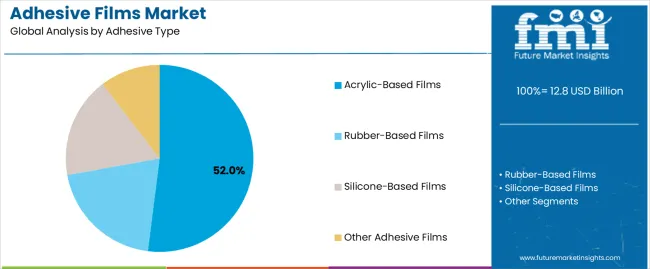
The acrylic-based films segment is projected to account for 52% of the adhesive films market in 2025, reaffirming its position as the leading adhesive category. Manufacturers and industrial users increasingly utilize acrylic-based films for their superior aging resistance characteristics, established UV stability, and essential functionality in permanent bonding applications across diverse industrial categories. Acrylic-based films' standardized performance characteristics and proven adhesion effectiveness directly address user requirements for reliable long-term bonding and optimal temperature resistance value in demanding applications.
This adhesive segment forms the foundation of modern industrial bonding patterns, as it represents the chemistry with the greatest commercial acceptance potential and established compatibility across multiple substrate systems. Manufacturing investments in formulation optimization and performance standardization continue to strengthen adoption among quality-conscious fabricators. With users prioritizing adhesion durability and environmental resistance, acrylic-based films align with both performance objectives and application requirements, making them the central component of comprehensive industrial bonding strategies.
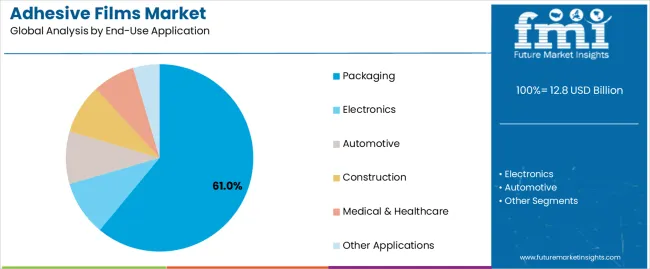
Packaging is projected to represent 61% of the adhesive films market in 2025, underscoring its critical role as the primary application for efficiency-focused manufacturers seeking superior sealing benefits and enhanced barrier credentials. Commercial users and packaging converters prefer packaging applications for their established volume demand patterns, proven cost-effectiveness, and ability to maintain exceptional production throughput while supporting flexible format offerings during diverse packaging experiences. Positioned as essential applications for productivity-driven operations, packaging offerings provide both volume excellence and operational advantages.
The segment is supported by continuous improvement in film extrusion technology and the widespread availability of established converting infrastructure that enables quality assurance and premium positioning at the brand level. Additionally, packaging material suppliers are optimizing film constructions to support market differentiation and accessible material pricing. As adhesive technology continues to advance and brands seek distinctive packaging solutions, packaging applications will continue to drive market growth while supporting product protection and consumer convenience strategies.
The adhesive films market is advancing rapidly due to increasing bonding efficiency consciousness and growing need for pressure-sensitive attachment choices that emphasize superior application outcomes across manufacturing segments and assembly operations. However, the market faces challenges, including higher material costs for specialty formulations, application technique requirements for optimal results, and environmental concerns affecting disposal practices. Innovation in bio-based adhesive systems and recyclable film development continues to influence market development and expansion patterns.
The growing adoption of adhesive films in electronics manufacturing and display assembly operations is enabling producers to develop bonding patterns that provide distinctive protection benefits while commanding premium positioning and enhanced performance characteristics. Electronic applications provide superior optical clarity while allowing more sophisticated thermal management across various device categories. Users are increasingly recognizing the competitive advantages of adhesive film positioning for premium component assembly and efficiency-conscious production integration.
Modern adhesive film manufacturers are incorporating advanced release systems, repositionable adhesive technologies, and residue-free removal protocols to enhance application capabilities, improve user outcomes, and meet commercial demands for clean-peel bonding solutions. These systems improve handling effectiveness while enabling new applications, including temporary protective films and specialized graphic lamination programs. Advanced technology integration also allows manufacturers to support premium market positioning and innovation leadership beyond traditional film operations.
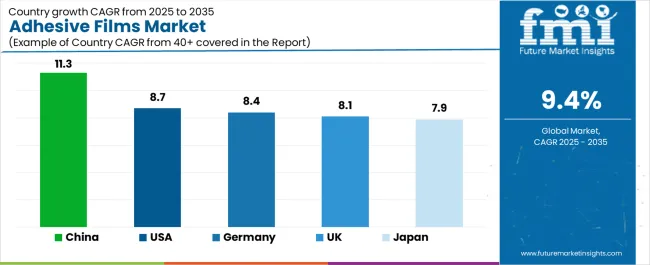
| Country | CAGR (2025-2035) |
|---|---|
| USA | 8.7% |
| Germany | 8.4% |
| UK | 8.1% |
| China | 11.3% |
| Japan | 7.9% |
The adhesive films market is experiencing robust growth globally, with China leading at an 11.3% CAGR through 2035, driven by the expanding electronics manufacturing sector, growing flexible packaging adoption, and increasing demand for protective film products. The USA follows at 8.7%, supported by rising automotive lightweighting trends, expanding medical device production, and growing acceptance of pressure-sensitive bonding solutions. Germany shows growth at 8.4%, emphasizing established automotive markets and comprehensive industrial film development. The UK records 8.1%, focusing on premium specialty films and advanced packaging expansion. Japan demonstrates 7.9% growth, prioritizing precision electronic applications and technological advancement.
The report covers an in-depth analysis of 40+ countries top-performing countries are highlighted below.
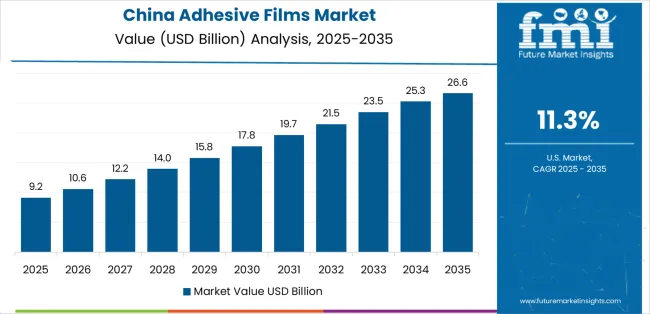
Revenue from adhesive films consumption and sales in the USA is projected to exhibit exceptional growth with a CAGR of 8.7% through 2035, driven by the country's rapidly expanding electronics sector, favorable manufacturing attitudes toward advanced bonding materials, and initiatives promoting lightweighting optimization across major industrial regions. The USA's position as a leading automotive market and increasing focus on flexible packaging development are creating substantial demand for high-quality adhesive films in both industrial and commercial markets. Major manufacturing companies and specialty film converters are establishing comprehensive production capabilities to serve growing bonding demand and emerging protective film opportunities.
Revenue from adhesive films products in Germany is expanding at a CAGR of 8.4%, supported by rising automotive sophistication, growing industrial automation, and expanding specialty film infrastructure. The country's developing advanced manufacturing capabilities and increasing commercial investment in performance materials are driving demand for adhesive films across both imported and domestically produced applications. International film manufacturers and domestic converters are establishing comprehensive operational networks to address growing market demand for quality adhesive films and specialty bonding solutions.
Revenue from adhesive films products in the UK is projected to grow at a CAGR of 8.1% through 2035, supported by the country's mature industrial market, established manufacturing culture, and leadership in specialty film standards. Britain's sophisticated aerospace infrastructure and strong support for advanced materials are creating steady demand for both traditional and innovative adhesive film varieties. Leading manufacturing companies and specialty film converters are establishing comprehensive operational strategies to serve both domestic markets and growing export opportunities.
Revenue from adhesive films products in China is projected to grow at a CAGR of 11.3% through 2035, driven by the country's emphasis on electronics expansion, manufacturing leadership, and sophisticated production capabilities for devices requiring specialized protective film varieties. Chinese manufacturers and distributors consistently seek industrial-grade materials that enhance product quality and support assembly operations for both traditional and innovative electronic applications. The country's position as an Asian manufacturing leader continues to drive innovation in specialty adhesive film applications and commercial production standards.
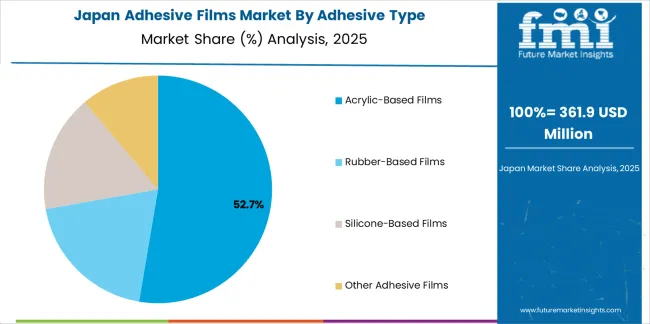
Revenue from adhesive films products in Japan is projected to grow at a CAGR of 7.9% through 2035, supported by the country's emphasis on precision manufacturing, electronics standards, and advanced material integration requiring efficient bonding solutions. Japanese businesses and electronics manufacturers prioritize optical performance and adhesion precision, making adhesive films essential materials for both traditional and modern assembly applications. The country's comprehensive manufacturing excellence and advancing electronics patterns support continued market expansion.
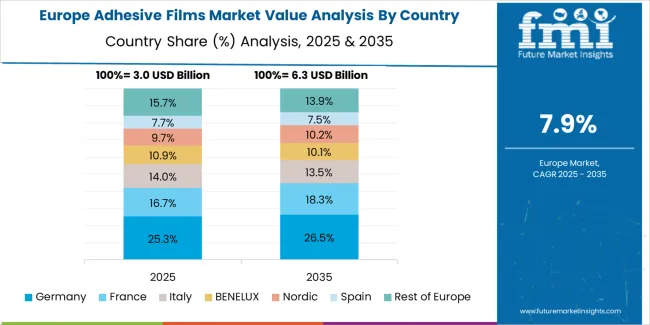
The Europe adhesive films market is projected to grow from USD 4.2 billion in 2025 to USD 9.8 billion by 2035, recording a CAGR of 8.9% over the forecast period. Germany leads the region with a 36.0% share in 2025, moderating slightly to 35.5% by 2035, supported by its strong automotive culture and demand for premium, performance-oriented adhesive film products. The United Kingdom follows with 24.0% in 2025, easing to 23.5% by 2035, driven by a sophisticated aerospace market and emphasis on specialty films and advanced material standards.
France accounts for 18.0% in 2025, rising to 18.5% by 2035, reflecting steady adoption of industrial bonding solutions and manufacturing consciousness. Italy holds 9.5% in 2025, expanding to 10.2% by 2035 as packaging innovation and specialty film applications grow. Spain contributes 7.0% in 2025, growing to 7.5% by 2035, supported by expanding automotive production and flexible packaging handling. The Nordic countries rise from 4.5% in 2025 to 4.8% by 2035 on the back of strong technology adoption and advanced manufacturing integration. BENELUX remains at 1.0% share across both 2025 and 2035, reflecting mature, specialty-focused markets.
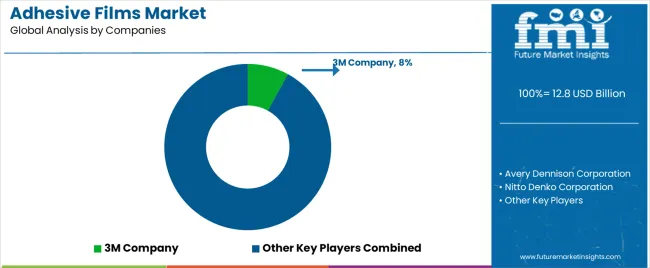
The adhesive films market is characterized by competition among established chemical manufacturers, specialized film technology providers, and integrated material solution companies. Companies are investing in adhesive chemistry technologies, advanced coating systems, product innovation capabilities, and comprehensive distribution networks to deliver consistent, high-quality, and reliable adhesive film products. Innovation in formulation enhancement, release liner methods, and application-specific product development is central to strengthening market position and customer satisfaction.
3M Company leads the market with a strong focus on adhesive innovation and comprehensive film solutions, offering industrial bonding systems with emphasis on performance excellence and technological heritage. Avery Dennison Corporation provides specialized pressure-sensitive capabilities with a focus on global market applications and materials engineering networks. Nitto Denko Corporation delivers integrated specialty film solutions with a focus on electronics positioning and optical performance. Lintec Corporation specializes in comprehensive industrial films with an emphasis on protective applications. Scapa Group focuses on comprehensive technical films and specialty solutions with advanced engineering and premium positioning capabilities.
The success of adhesive films in meeting industrial bonding demands, manufacturing-driven performance requirements, and quality assurance integration will not only enhance production outcomes but also strengthen global manufacturing capabilities. It will consolidate emerging regions' positions as hubs for efficient film converting and align advanced economies with commercial material systems. This calls for a concerted effort by all stakeholders -- governments, industry bodies, manufacturers, distributors, and investors. Each can be a crucial enabler in preparing the market for its next phase of growth.
| Items | Values |
|---|---|
| Quantitative Units (2025) | USD 12.8 billion |
| Adhesive Type | Acrylic-Based Films, Rubber-Based Films, Silicone-Based Films, Other Adhesive Films |
| Backing Material | Polyester Films, Polyethylene Films, Polypropylene Films, Paper-Backed Films |
| Technology | Solvent-Based Adhesives, Water-Based Adhesives, Hot-Melt Adhesives |
| End-Use Application | Packaging, Electronics, Automotive, Construction, Medical & Healthcare, Other Applications |
| Regions Covered | North America, Europe, Asia Pacific, Latin America, Middle East & Africa, Other Regions |
| Countries Covered | United States, Germany, United Kingdom, China, Japan, and 40+ countries |
| Key Companies Profiled | 3M Company, Avery Dennison Corporation, Nitto Denko Corporation, Lintec Corporation, Scapa Group, and other leading adhesive film companies |
| Additional Attributes | Dollar sales by adhesive type, backing material, technology, end-use application, and region; regional demand trends, competitive landscape, technological advancements in coating engineering, formulation integration initiatives, performance enhancement programs, and premium product development strategies |
The global adhesive films market is estimated to be valued at USD 12.8 billion in 2025.
The market size for the adhesive films market is projected to reach USD 31.4 billion by 2035.
The adhesive films market is expected to grow at a 9.4% CAGR between 2025 and 2035.
The key product types in adhesive films market are acrylic-based films, rubber-based films, silicone-based films and other adhesive films.
In terms of end-use application, packaging segment to command 61.0% share in the adhesive films market in 2025.






Full Research Suite comprises of:
Market outlook & trends analysis
Interviews & case studies
Strategic recommendations
Vendor profiles & capabilities analysis
5-year forecasts
8 regions and 60+ country-level data splits
Market segment data splits
12 months of continuous data updates
DELIVERED AS:
PDF EXCEL ONLINE
Market Share Breakdown of Adhesive films market Industry
Self-adhesive Films Market Size and Share Forecast Outlook 2025 to 2035
Competitive Overview of Self-Adhesive Films Market Share
Thermoplastic Adhesive Films Market Size and Share Forecast Outlook 2025 to 2035
Adhesives for Electric Vehicle Power Batteries Market Forecast and Outlook 2025 to 2035
Adhesive Tester Market Size and Share Forecast Outlook 2025 to 2035
Adhesives And Sealants Market Size and Share Forecast Outlook 2025 to 2035
Adhesive Modifier Market Analysis - Size, Share, and Forecast Outlook 2025 to 2035
Adhesive Transfer Tape Market Growth, Trends, Forecast 2025 to 2035
Assessing Adhesive Transfer Tape Market Share & Industry Insights
Adhesive for Resilient Floor Market Growth – Trends & Forecast 2024-2034
Adhesive Bubble Wrap Market
Adhesive Removers Market
UV Adhesives Market Size and Share Forecast Outlook 2025 to 2035
Bioadhesives for Packaging Market
Non-Adhesive Tags Market Growth - Demand & Forecast 2025 to 2035
Tile Adhesive Market Size and Share Forecast Outlook 2025 to 2035
Self-Adhesive Dual-Cure Luting Cement Market Size and Share Forecast Outlook 2025 to 2035
Self-adhesive Tear Tape Market Size and Share Forecast Outlook 2025 to 2035
Self-Adhesive Labels Market Size and Share Forecast Outlook 2025 to 2035

Thank you!
You will receive an email from our Business Development Manager. Please be sure to check your SPAM/JUNK folder too.
Chat With
MaRIA